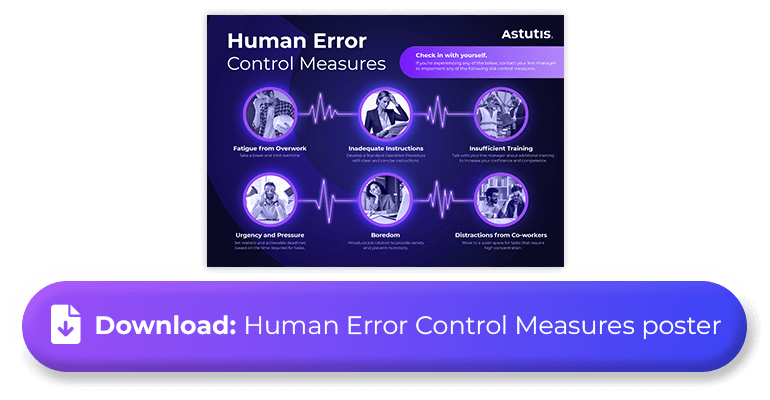How Do Human Errors Affect Health and Safety? Free Poster
No matter how well-skilled and thoroughly trained your employees are, accidents can and will happen in every workplace. Depending on the severity of the human error, this can have devastating consequences. According to an analysis of accidents and incidents by the Health and Safety Executive (HSE), human error almost always contributes to all accidents and exposures to substances hazardous to health. In fact, many major accidents in recent memory, such as Chernobyl, were initiated by human error.
As a part of their legal responsibilities for health and safety, organisations need to expect and anticipate human errors as robustly as possible.
What is Human Error?
Broadly speaking, human error refers to actions or decisions made by a person that deviate from what is intended or expected, leading to undesirable outcomes. It is important to remember that human error is not a deliberate action but rather a lapse in judgment, attention, or skill.
In safety terms, human errors are often described as accidents brought on by the actions of a person and not by failures of machinery, equipment, tools or surroundings.
Another term used widely in the subject of human failures for health and safety is ‘Violations’. A violation is a deliberate deviation from health and safety procedures and best practices. Violations are not always malicious and can be well-intentioned. The key difference is that violations are intentional, while accidents and incidents are unintentional.
Common Types of Human Errors
There are three types of unintentional human errors.
- Slips: Not a physical slip. Scenarios such as pressing the wrong button or reading an incorrect gauge.
- Lapses: Situations like forgetting to carry out a step in a procedure.
Slips and lapses occur during familiar tasks. These types of errors occur commonly in well-trained, day-to-day procedures where the person performing them might not need to concentrate on what they’re doing. These kinds of errors cannot be eliminated with more training, but improvements in design can reduce their likelihood.
- Mistakes: Errors of judgment or decision-making where the actions intended are fundamentally wrong. Doing the wrong thing believing it to be right.
Mistakes mainly occur because an employee does not fully understand the rules and procedures or does not know how to perform the task in the correct way. They tend to occur when the person does not actually know the correct way of carrying out the task, either because it’s new and completely unexpected to them or because they have not been trained correctly. Sometimes it can be a combination of the two. Training based on good procedures is usually the remedy for this.
Causes of Human Error
There are several causes of human error, and oftentimes, the reasoning is well out of the individual's control, such as:
- Fatigue from overwork.
- Inadequate instructions.
- Insufficient training.
- Poor working environments.
- Unfair deadlines that create too much urgency and pressure.
- Boredom.
- Distractions from co-workers.
Our human errors free poster below is great way to remind employees what they can do if they find themselves experiencing any causes of human errors.
Safety Consequences of Human Errors in the Workplace
Human errors can have very severe consequences for health and safety in the workplace if they are not appropriately guarded against. Consequences include:
- Injuries and Fatalities: The most immediate and devastating consequence of human errors in health and safety is the physical harm to someone or a group of people.
- Financial: Human errors can also lead to very sizable financial losses due to medical expenses, compensation claims, and increased insurance premiums. Costs can also be incurred from damaged equipment or infrastructure.
- Productivity Loss: Errors cause workflow disruptions, leading to downtime and decreased productivity. For example, improper use of machinery can lead to breakdowns, halting production lines.
- Organisation Reputational Damage: Repeated incidents of human error can earn an organisation a reputation as a poor practitioner, leading to a loss of business and trust from stakeholders.
Principles of Managing Human Error
The real challenge comes from developing error-tolerant control measures to manage human errors proactively. The best way is to account for it during the risk assessment process. Human errors are not completely random. They are normal and sometimes instinctual behaviours that can be anticipated, identified and managed.
Organisations can manage human error by ensuring staff have clear instructions on how to perform their tasks and fully understand what is expected of them regarding health and safety. Tasks should be pre-planned and only assigned to those who know how to carry them out safely and effectively.
Make deadlines reasonable and achievable and be sure to rotate workstations to avoid burnout or boredom. Rotating workstations might also improve worker morale thanks to increased variety. Minimise distractions and allocate appropriate supervision so employees can get assistance when needed.
Human Error Impacts for Accident Investigation
As HSE reported, human errors play a huge role in most accidents. That’s why you should have a firm grasp of the concept if you are responsible for investigating accidents in your organisation.
Proper training in investigative practice will provide you with the skills and knowledge you need to conduct thorough and effective investigations.
The Certified Serious and Major Accident Investigator (Level 6 - Advanced Practitioner) course is structured to provide a blend of theoretical knowledge and practical application, ensuring that learners can immediately apply what they have learned to real-world situations. Key features of the course include:
- In-depth modules on advanced investigative techniques.
- Practical exercises and case studies to reinforce learning.
- Guidance on navigating legal and regulatory frameworks.
- Training on effective report writing and presentation of findings.
Participants who complete the course below and are successful in the assessment will receive a certification that is recognised by industry professionals and employers, enhancing their credibility and career prospects.

Real Life Stories





